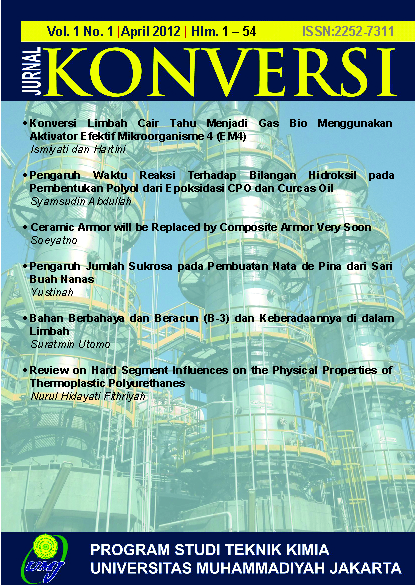KONVERSI LIMBAH CAIR TAHU MENJADI GAS BIO MENGGUNAKAN AKTIVATOREFEKTIF MIKROORGANISME 4 (EM4)
Main Article Content
Abstract
ABSTRACT. Tofu liquid waste has a high potential to pollute water ecosystem, because so far it is disposed as is to sewerages around tofu factories. Nevertheless, tofu liquid waste is potentially convertible into biogas because it has BOD and COD exceeding 4000 mg/lt.The production of biogasfrom tofu liquid waste using an activator Effective Microorganism (EM4) is influenced by several underlying factors: volumes of waste,goat rumen and EM4. The objective of this study is to understand the feasibility of tofu liquid waste as a raw material of biogas, using additional materials of goat rumen and EM4 activator. The experiments were carried out in 5 batch reactors filled with 3000 ml waste and 300 ml rumen, and added with EM4activator varied for 0 ml, 25 ml, 50 ml, 75 ml and 100 ml. Based on our observations, it can be concluded that the addition of EM4in a batch process is positively correlated to the organicdecay of tofu liquid waste into biogas. The best result was observed in Reactor IV containing 75mlEM4where the biogas was produced after 72 hours. Keywords: tofu liquid waste, EM4 activator, cattle rumen, biogas
Article Details
Issue
Section
Articles
Authors who publish with this journal agree to the following terms:
- Authors retain copyright and grant the journal right of first publication with the work simultaneously licensed under a Creative Commons Attribution License that allows others to share the work with an acknowledgement of the work's authorship and initial publication in this journal.
- Authors are able to enter into separate, additional contractual arrangements for the non-exclusive distribution of the journal's published version of the work (e.g., post it to an institutional repository or publish it in a book), with an acknowledgement of its initial publication in this journal.
- Authors are permitted and encouraged to post their work online (e.g., in institutional repositories or on their website) prior to and during the submission process, as it can lead to productive exchanges, as well as earlier and greater citation of published work (See The Effect of Open Access).
